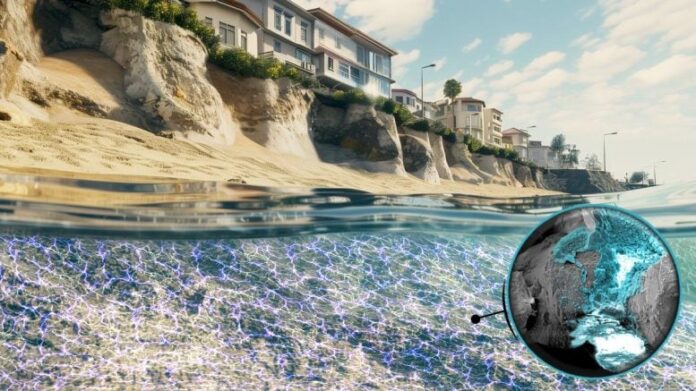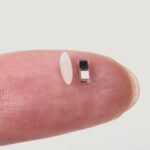Northwestern University researchers, inspired by how sealife builds shells using the minerals dissolved in seawater, have proposed using low-voltage electrical currents to solidify beach sand and turn it into a natural cement barrier for shoring up endangered coastlines.
An article appearing on August 22, 2024, in the journal Communications Earth & Environment, describes electrochemical laboratory experiments on seawater-soaked sand calcareous mineral precipitates forming calcium carbonate (limestone), and magnesium hydroxide (hydromagnesite). The researchers propose passing low-voltage electricity through shoreline beach areas to turn them into solid rock to resist rising seas. It argues that this method is more effective and cheaper than building seawalls.
The use of electricity with seawater to promote electrodeposition is not new. It is used today to protect built shoreside infrastructure to make them more resistant to corrosion and cracks. It is used as well to cement marine materials to metal structures along shorelines. In some experiments, it is being used to restore the integrity of damaged coral reefs.
What hasn’t been done before is using the electrodeposition of marine soils of varying density and composition to create barriers to rising seas. The Northwestern research team, therefore, decided to run experiments to determine if they could electrify marine sediments to solidify them. The team tested suitable soils, different seawater chemistry and levels of applied voltage to determine what would yield the best electro-solidification. In laboratory tests, a low-voltage electric current passing through marine sand produced electro-cohesive bonding and soil cementation.
Northwestern’s Professor Alessandro Rotta Loria, is in the Department of Civil and Environmental Engineering, Subsurface Opportunities and Innovations Laboratory. He told Amanda Morris in an August 22, 2024 interview published in Northwestern Now why the team decided to investigate this line of research. He noted that “Over 40% of the world’s population lives in coastal areas. Because of climate change and sea-level rise, erosion is an enormous threat to these communities.”
The researchers were inspired by how marine life uses the natural chemistry in seawater to create protective shells. Could the sand and soil in shorelines be stimulated through an electrochemical process to produce a cement-like barrier to hold back rising seas? The team, Rotta Loria said, hoped to “develop an approach capable of changing the status quo in coastal protection — one that didn’t require the construction of protection structures and could cement marine substrates without using actual cement.” He went on to describe the method chosen. “By applying a mild electric stimulation to marine soils, we systematically and mechanistically proved that it is possible to cement them by turning naturally dissolved minerals in seawater into solid mineral binders — a natural cement.”
The success of this experiment may prove a timely solution for American seaside communities like Norfolk, Virginia which is experiencing faster-than-average sea level rise. Norfolk has been building berms and seawalls to hold back the Atlantic Ocean. Conventional seawalls however are not proving to be lasting solutions.
In my travels, I have witnessed seawall failures. One that comes to mind happened in Fort Lauderdale a few years ago. The city had spent $11.8 million in 2015 to build a wave wall barrier to mitigate against future hurricanes and “storms of the century.” Even during construction, however, the wall was breached by higher-than-normal seasonal tides, not even a hurricane.
Why are seawalls a poor solution to address sea level rise and storm surges? They customarily are built using rebar-reinforced concrete. Reinforced concrete and seawater don’t mix. A good example of this happened in Surfside, Florida, where a building with primary weight-load structures built of reinforced concrete collapsed in 2021. Reinforced concrete in the presence of seawater erodes. The force of tides and storm surges accelerates the process. Internally, as seawater seeps in through cracks, carbonation from carbonic acid forming causes the rebar to rust further accelerating the disintegration from the inside out. Build a seawall out of this material and like the building in Surfside, the wall will inevitably fail.
Alternative strategies being used by coastal towns involve pumping cement directly into the ground along shorelines. This method has proven to be no more effective than seawalls when addressing high tides and storm surges.
A hybrid strategy for coastal communities with existing seawalls could, if lying atop the right soil or sand foundation, apply a 2 to 3-volt current beneath the wall to produce cementation that reinforces and binds the wall to it making a more resilient impermeable barrier to a rising ocean and high tides.
In the event no seawall is present, then the low-voltage solution when applied to marine sand and soil could produce a barrier stronger than concrete, more formidable and lasting. That’s because, in the laboratory, Rotta Loria has observed that treated sand does not need further interventions and produces “remarkable outcomes from just a few days of stimulations.”
If you are concerned about getting shocked by the electricity beneath the sand, Rotta Loria notes that the voltage is too mild to feel and would have no negative impact on wildlife. So what erosion-threatened beachside town in the United States wants to be Northwestern’s first guinea pig?









